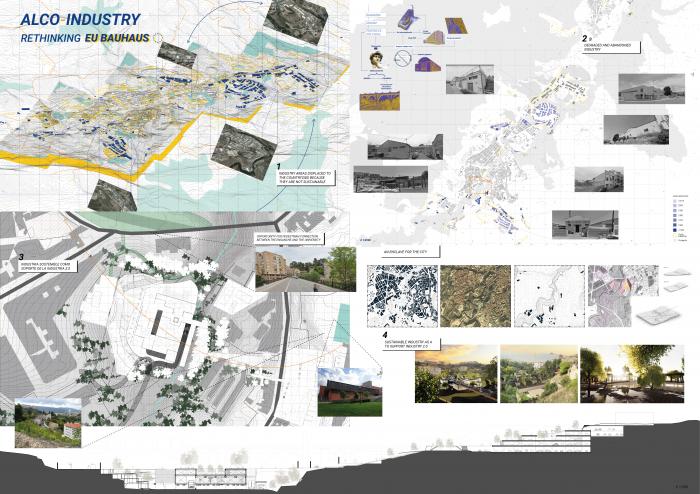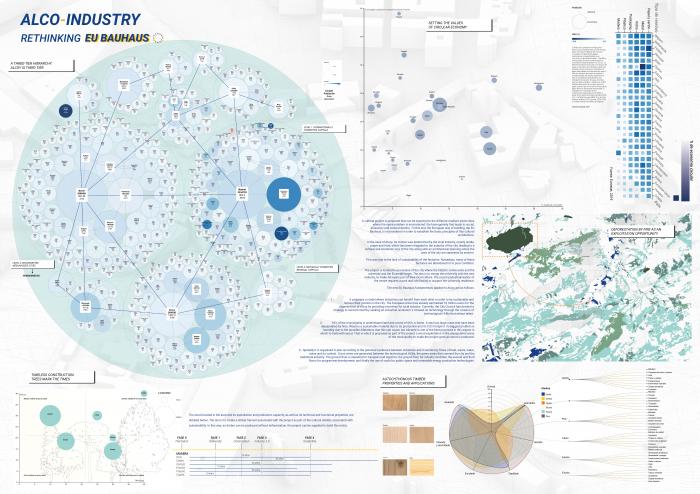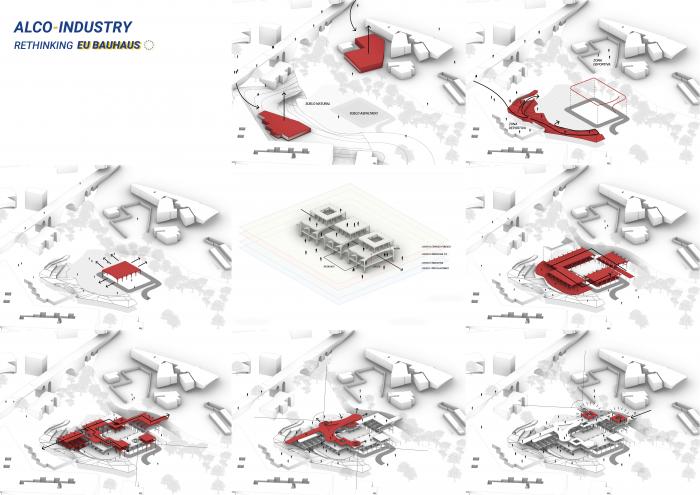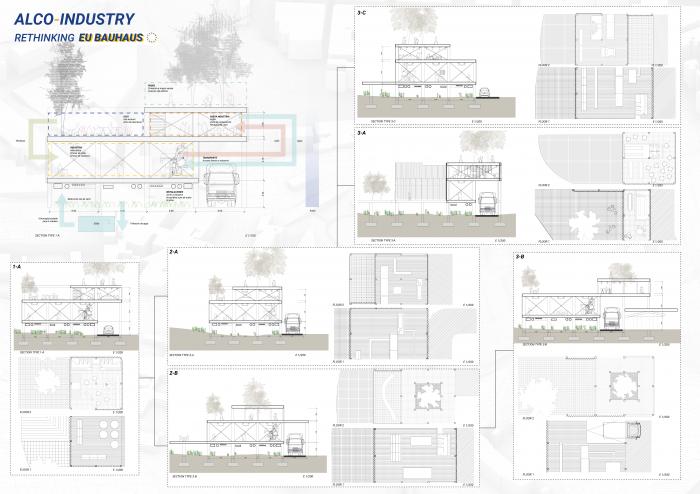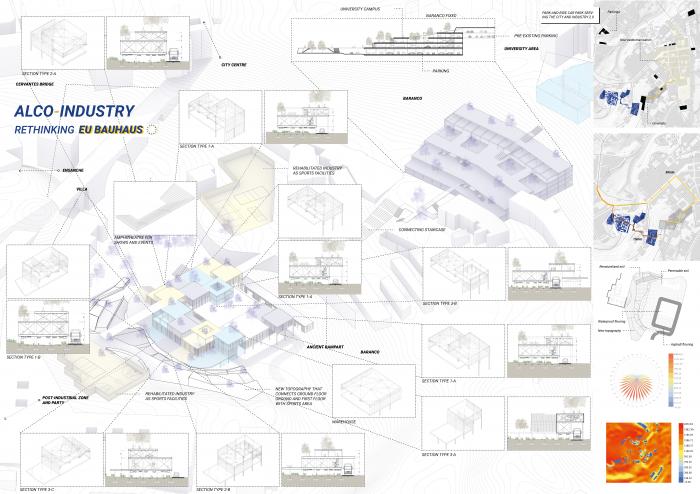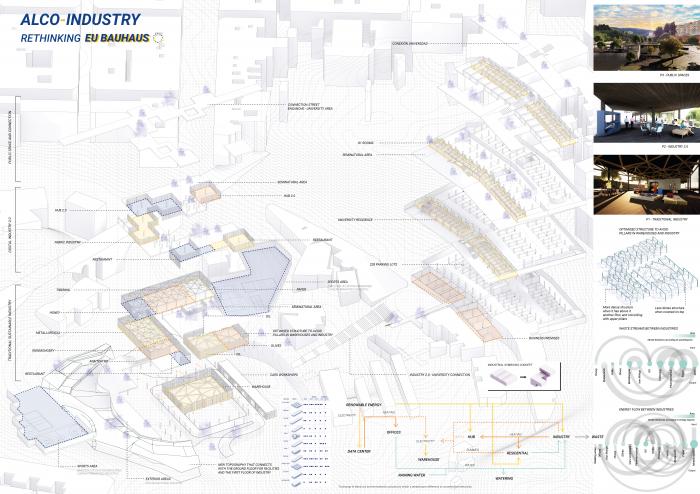An industrial symbiosis is proposed in an enclave of the city of Alcoy where its local industry began and was forced to leave because it was not sustainable. In this way, the idea of local culture is reinforced through a series of ideas based on the new European way of building. Therefore, culture is promoted on two levels through architecture in order to escape from the homogenisation that the city suffers from along with other cities of similar characteristics.
A cultural project is proposed that can be exported to the different medium-sized cities where the same problem is encountered: the homogeneity that leads to social, economic and cultural decline. To this end, the European way of building, the EU Bauhaus, is reconsidered in order to establish the basic principles of this cultural architecture.
In the case of Alcoy, its culture was determined by the local industry, mainly textile, paper and food, which has been relegated to the suburbs of the city, leading to a cultural and economic loss of the city along with an architectural planning where the uses of the city are separated by sectors.
This was due to the lack of sustainability of the factories. Nowadays, many of these factories are abandoned or in poor condition.
Please highlight how the concept/idea can be exemplary in this context
Industries benefit from each other through a flow of waste, water and energy. The programme is distributed according to these parameters, bringing industries together where symbiosis can be created.
Thus, traditional industry is on the first floor, supplying value to the first floor, where industry 2.0 is located. For example, rainwater collected on the roof is used for the paper and wood industry. The waste from the paper and wood industry is burned as biofuel to produce heat.
Therefore, in order to be able to access this model, it is necessary to study beforehand what the new industry can contribute to the whole and what it can receive from the rest.
Please highlight how the concept/idea can be exemplary in this context
Spatially it is organised in plan according to the potential symbiosis between industries and in section by flows of heat, waste, water, noise and its context. Cross views are generated between the technological HUBs, the green areas that connect the city and the traditional industry. The ground floor is intended for transport and logistics; the ground floor for industry facilities; the second and third floors for programme development; and finally the use of roofs for public space and renewable energy production technologies.
Please highlight how the concept/idea can be exemplary in this context
The project is located in an enclave of the city where the historic centre ends and the university and the Eixample begin. The aim is to merge the university with the new industry, to make Alcoyans part of their local culture. The recent pedestrianisation of the centre requires a park and ride facility to support the university residence.
Please highlight how this approach can be exemplary
When spatiality, the circular economy and a local sense of belonging come together, a socially acceptable model of sustainable industry can be created.
In this way, all citizens are involved in the project so that they can inhabit it.
This model can be exported following the premises of low embedded and operational carbon emissions, i.e. under the use of sustainably and locally produced wood and through the use of renewable energies. Along with the symbiosis between industries, this can reinforce the idea of a European culture that not only favours local culture, but also creates a sense of belonging to society as a whole.
Thus, the project sows a series of ideas, and the people water it, so that anywhere in Europe you can sow the idea and create a totally different result under the same ideas.
It proposes a model where industries can benefit from each other in order to be sustainable and recover their position in the city. The European Union has already earmarked 10 million euros for the regeneration of Alcoy by providing incentives for local industry. Currently, the City Council has devised a strategy to reinvent itself by seeking an industrial revolution 2.0 based on technology through the creation of technological HUBs that attract talent.
92% of the municipality is undeveloped land and a total of 60% is forest. It also has large areas that have been depopulated by fires. Wood is a sustainable material due to its production and its CO2 footprint. Its biggest problem is humidity due to the possible dilatations that this can cause, but Alicante is one of the best provinces in this aspect in which to build with wood. That is why it is proposed as part of the project a wood exploitation in the unpopulated areas of the municipality to make the project grow as wood is produced.
I would foster the idea of belonging to the European Union in different countries by promoting local projects on a smaller scale than Alco-industry, with the aim of de-homogenising medium-sized cities and preventing the homogenisation of larger cities. Meanwhile, in rural areas, I would provide ideas to maintain local culture in order to reinforce the idea of European culture through the European way of building.
@Guillen Barrero, 2022
Content licensed to the European Union.
